- Home
- Peter F. Hamilton
The Confederation Handbook
The Confederation Handbook Read online
The Confederation Handbook
Peter F. Hamilton
The Confederation Handbook
The Night’s Dawn trilogy has been one of the most triumphant works of science fiction to appear in decades. Swiftly gathering a worldwide readership, this masterwork of cosmic imagination and storytelling amounts to more than 1,200,000 words in total, and has brought to life an entire galaxy of diverse planets and astonishing civilizations.
At the core of this vast creation is the Confederation itself: an assembly of human and alien colony worlds whose cultures, conflicts, and turmoils are described over a Timeline of nearly six hundred years.
The Confederation Handbook is Peter F. Hamilton’s essential companion guide to the diverse elements of the massive universe he has created. Here we have his personal exposition of the Adamist and Edenist cultures; numerous alien races; a battery of starships, weapons, and other technology; and a vast confederation of planets and settlements. Also included is a full list of characters and their roles and, of course, details of the Timeline itself.
Peter F. Hamilton began writing in 1987 and published a number of short stories as well as three SF/detective novels before he wrote The Reality Dysfunction and its sequels. He was profiled by Locus magazine in 1998.
From the arcologies of Earth to the shards of the Ruin Ring, uncover the . . .
MYSTERIES OF THE NIGHT’S DAWN UNIVERSE
• Why is the Kulu Intelligence Service so feared?
• What are the differences between blackhawks and voidhawks?
• Why can’t the Weeping Rose be grown anywhere except on Norfolk?
• Why are Cosmoniks so modified, and are they all still human?
• What do Kiint really look like?
• Why is the Jiciro world off-limits?
• Why did the Nyvan colony collapse into war and anarchy?
• Why is life better in the Halo than on Earth?
The answers to these and many other questions are contained in a companion guide as wondrous and revealing as only the epic scope of The Night’s Dawn could provide . .
THE CONFEDERATION HANDBOOK
ACCLAIM FOR PETER HAMILTON’S TRILOGY
THE REALITY DYSFUNCTION
THE NEUTRONIUM ALCHEMIST
THE NAKED GOD
“This series is taking on one of sf’s (and maybe all of literature’s) primal jobs: the creation of a world
with the scale and complexity of the real one.”
—Locus
“Hamilton’s imagination knows no bounds!”
—Science Fiction Weekly
“Hamilton’s joy in science-tethered flights of fancy is infectious.”
—Interzone
“Absolutely vintage science fiction. . . . Hamilton puts [sf] back into interstellar overdrive. An intergalactic adventure story laced with ironies, insights, and held together by a transcending central
plot.”
—The Times(London)
“Eloquent and ingenious. . . . A host of believable characters deploy against rich descriptions of worlds and living starships. Horror and heroism and even the humor are convincing. . . . Special effects run
riot. . . . It all hangs together compulsively.”
—Daily Telegraph(London)
“Brash, broad space opera with military hardware galore. Fast movement and dazzling invention.”
—Gregory Benford, author ofThe Martian Race
“Super-intelligent space opera, wrought by an author who knows his stuff . . . and it’s a rattling page-turner, too. . . . An astonishing read crammed with golden-age wonders, but all depicted with an intellectual toughness that marks this as a landmark work.”
—Stephen Baxter, author ofThe Time Ships
ALSO BY PETER F. HAMILTON
The Night’s Dawn Trilogy
The Reality Dysfunction*
The Neutronium Alchemist*
The Naked God*
A Second Chance at Eden* (Short stories set in the Night’s Dawn universe)
Fallen Dragon*
Futures*
(Novellas by Peter F. Hamilton, Stephen Baxter, Paul McAuley,
and Ian McDonald)
The Greg Mandel novels
Mindstar Rising
A Quantum Murder
The Nano Flower
*available from Warner Aspect
Contents
The Confederation in 2611
One: Adamist Culture
Nanonics
Cosmoniks
Mercenaries
Exowombs
Education
Governments
Religion
Colonization
Constitutions
Asteroid Settlements
Defense
Two: Edenist Culture
Identity Continuity and Habitat Consciousness
Genetic Engineering
Exowombs and Reproduction
Education
Culture
Religion
Serpents
Converts
Government
Law
Currency
Economy
Finance
Industry
Trade
Habitats
Layout and Composition
Starscrapers
Power
Light
Climates
Mechanical Systems
Spaceport
Defense
Voidhawk Base Habitats
The Hundred Families
The Atlantis Islands
Economy
Three: Starships and Weapons
Voidhawks
Propulsion
Operating Parameters
Structure
Power
Reproduction
Blackhawks
Adamist Starships
FTL Drive Operation
Astrogation
Structure
Fusion Drive
Antimatter Drive
Combat Wasps
Zero-Tau
Antimatter Planet-Busters
Four: Members of the Confederation in 2610
The Confederation Navy
Confederation Navy Intelligence Service
1. Sol System
Earth
The O’Neill Halo
Independent Asteroid Settlements
The Moon–Mars Partnership
2. Kulu
Physical Data
Star System Physical Data
The Kulu Kingdom
3. The Principality of Ombey
Star System Physical Data
The Planet Ombey
4. Tranquillity
Star System Physical Data
Tranquillity
The Ruin Ring
5. Avon
Star System Physical Data
Avon
Trafalgar
6. Lalonde Star System Physical Data
Lalonde
7. Norfolk Star System Physical Data
Norfolk
Plants
8. Nyvan
Star System Physical Data
Nyvan
9. The Dorados
Star System Physical Data
Dorados
10. New California
Star System Physical Data
New California
11. Srinagar
Srinagar
Valisk
12. Valisk
Five: Sentient Xenoc Species
1. Tyrathca
A. From Pre-2611 Information
B. From Post–2611 Information
2. Kiint
A. From Pre–2611 Information
B. From Post–2611
Information
3. Jiciro
Six: Principal Characters
A. The Main Protagonists
B. Other Leading Figures
By Ship
By Habitat
By Asteroid
By Planet
Others
Seven: Timeline
About the Author
THE CONFEDERATION IN 2611
There are two major human cultures at this time: the Adamist and the Edenist.
They are split by their different attitudes towards the affinity gene.
One: Adamist Culture
Adamists define themselves as normal humans, a classification governed by their lack of an affinity gene. The name derives from the biblical Adam, who was first and therefore untainted. It was also an obvious choice, given that those who possessed an affinity gene were principally living in the habitat Eden at the time (2090) when the two cultures began to diverge (A Second Chance at Eden). In general, Adamists live on colonized terracompatible planets and in asteroid settlements. A small number live in the five independent (non-Edenist) bitek habitats.
Thanks to genetic engineering (geneering), average Adamist life expectancy is approximately 115 years, though this can vary wildly. Most Adamists are now the recipients of geneering performed between 2050 and 2200, with descendants of European, North American, and Pacific Rim nations benefiting from the highest level of enhancements. There are three Confederation planets which are settled entirely by humans who have no genetic manipulation in their ancestry, all of which have pastoral- or religious-based constitutions. Some enclaves of “pure” humans also live on other worlds, though their numbers are now in decline due to constant contact with their geneered cousins. Most of those groups were founded on religious or ethical grounds. Although isolated during the first stages of colonization, such separatism from a planet’s mainstream culture is difficult to maintain. After learning of the outside world, the children of such groups normally find it very hard to understand why their ancestors have denied them this beneficial genetic heritage, and they tend to drift away from their enclaves.
With most hereditary diseases eradicated, organ efficiency improved, and substantial enhancement to the immune system, there is little need for geneering to be performed on fetuses now. The type of geneering which is still researched and practiced is concentrated principally on extending life expectancy. Among the very rich there is a fashion for having cosmetic geneering performed on their children; not just for classical beauty, but for blending of distinct racial traits, e.g. combining red hair with black skin.
The main exception to this slowdown of basic physiological alteration is the Royal Saldana family, whose members are still being modified for increased intelligence and memory capacity, and reduced sleep requirement, as well as expanding their life expectancy, which currently stands at 180 years. In short they are (ironically) becoming close to the Edenist ideal, lacking only affinity.
The second exception is the starship owner-operator families (such as the Calverts), who undergo dominant-gene modifications to cope with the long periods of zero-gee on their ships (again similar to that of Edenists). These families have eliminated vertiginous disorientation and organ decay, while bone-calcium levels will not decrease in the absence of gravity. Internal membranes are strengthened to cope with periods of high-gee acceleration (a function which is more commonly augmented with nanonic membranes), thus preventing organs from tearing, and their heart capacity has been increased to ensure their blood supply remains regular under acceleration.
Adamists, however, remain totally opposed to using the affinity bond (see below for exceptions). Although it began as a mild disagreement between users and nonusers to start with (2050–2090), this attitude is now irrevocably entrenched among them, and has become the symbolic difference between the two principal human cultures. Because of its association with bitek (which it was originally designed to control), this affinity-bond technology has also been virtually abandoned by Adamists. Both Islam and the Christian Unity Church have proscribed the affinity gene as inhuman. The rationale is that the affinity gene is not part of the genetic heritage which was given to us by God, but instead was artificially designed and has to be sequenced into a fetus’s DNA.
Geneering, which is the alteration (the more devout say “tampering with”) of existing genes, is permissible (principally because it brought so many medical benefits to the masses that it became impossible for nonfundamentalist Churches to oppose it). Shinto, Buddhism, and Hinduism are not so vigorous in their condemnation; affinity-bond domination of animals, or human communion, is not forbidden but it is frowned upon. No priests in those religions possess affinity bonds.
There are nevertheless some exceptions to this prohibition of employing the affinity bond. Because of cheapness, there is still a limited use of affinity-bonded animals on colony worlds in the first stages of their development (though never on Kulu Principality worlds), before an economy capable of producing domestic consumer mechanoids and cybernetics can be established. The application tends to die out after this phase, as servitor animals are replaced by mechanoids for all mundane tasks.
Such animals are mainly bought from Edenists, along with bitek products (typically landcoral for cheap housing). There are few Adamist sources for these products. Tropicana is virtually the only Adamist world which has no proscription against bitek, and its economy is based around selling affinity-bonded servitors and simple bitek to Adamists (it also has a large proportion of clinics offering rejuvenation treatments of dubious value). Bitek can also be purchased from the five independent habitats, which provide the most prominent exception to the Adamist refusal to use affinity bonds and bitek. These habitats are the main source of blackhawks, whose captain-owners are not the kind of people renowned for their religious principles. (For the origin of blackhawks see Valisk, page 208 .)
The other exception of note is the Lord of Ruin, who is affinity capable (see Tranquillity and Kulu Kingdom, pages 127 and 108).
Nanonics
Nanonic technology is widespread in Adamist culture. It is a broad-ranging term covering both artificial neural circuits and cellular-replacement systems, as well as medical packages. The most common are as follows.
Neural nanonics, a web of neural-amplification circuits that are meshed directly with the brain, providing a datavise link with electronic circuitry. Most Confederation processors have a datavise facility, enabling an operator to interface directly with equipment, spacesuits, vehicles, etc.; this also provides a link with local communication nets. Other principal functions include neuroiconic displays, imprinting data directly into the brain; enhanced memory capacity; control over implants; and physiological and medical monitoring. Neural nanonics also receive entertainment shows in the form of sensevises, and can play sensenviron memories immersing the recipient in a total artificial environment that has video, audio, tactile and olfactory components, allowing complete immersion in fantasy worlds. The most popular flek recordings are mood fantasy albums produced by artists such as Jezzibella, which can also be used through direct optical interfaces, although these lack the full impact of a direct sensevise. Inevitably there is always a big market for bluesense fleks everywhere in the Confederation.
This technology is extremely prevalent, with something like 75–80 percent of Confederation Adamist adults on developed planets fitted with neural nanonics. They are implanted only when the brain has stopped growing, i.e. at sixteen to eighteen years old. For anyone involved in up-to-date aspects of modern society they are essential: fewer and fewer technological systems are being built with manual interfaces, and professions such as medicine or starship crewing cannot be conducted without them.
The distaff side of neural nanonics is sequestration nanonics, which can be used to infiltrate a person’s cortex and puppet the entire body. These systems are highly illegal, and on most worlds their possession or use entails high penalties.
Government Intelligence agencies
and the police forces of more authoritarian planets also use debrief nanonics, which can probe the brain’s memory centers, extracting information directly.
Edenists do not use neural nanonics.
Medical nanonics come in packages of varying sophistication, which can be used for anything from patching up wounds in the field to complex deep-penetration operations. They consist of microfilaments with various functions, capable of treating individual cells. These include adding or extracting chemicals and proteins, filtering blood, knitting cells together (along a wound), and destroying and withdrawing malignant growths. Whereas first-aid packages can be operated by almost anyone with access to a controlling processor, the more complicated uses have to be supervised by qualified medical personnel. Medical packages are not autonomous.
Cosmoniks
These are industrial asteroid personnel whose bodies have atrophied due to extensive periods spent in zero-gee (“Astrophied” is the old Adamist joke). Their numbers are now in decline, as the modified genes which provide resistance to this condition are slowly spread throughout the human gene pool.
Biomechanical systems are used to supplement decaying muscle, bone, and organ tissue. Older cosmoniks (for whom the deteriorating condition is most advanced) have replaced their digestive tract and/or lungs with either artificial tissue or biomechanical organs to replenish the nutrients and oxygen in their blood supply. Skin is usually exchanged for a hard, dark, polymer layer resembling thick leather, enabling them to step directly into a vacuum or radiation environment without any other preparation or protection, though hard exoskeleton-type casing can also be used. Many have modified their basic humanoid structure, equipping their feet with gripping claws, giving themselves three forearms each with a specialist tool hand, etc. Most starships carry one or two cosmoniks as crew-members. In extreme cases, a cosmonik will abandon his humanoid form altogether, and transfer his brain into something like a small MSV (multifunction service vehicle). In effect, he then becomes a short-range spacecraft.
Mercenaries
Despite the relatively stable interstellar situation policed by the Confederation, soldiers for hire are still a large business. Although there are no longer any land wars or interstellar invasions, the requirement for limited “special forces” actions is at an all-time high. Asteroid-settlement rebellions against their founding companies are a frequent occurrence, with each side hiring mercenary groups to inflict strategic damage against the other. In the case of the companies, boosted mercenaries are usually employed to temporarily reinforce local police forces, while the rebels use their mercenaries to strike against the company’s assets in another star system.

 A Night Without Stars
A Night Without Stars If at First . . .
If at First . . .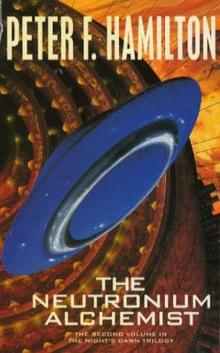 The Neutronium Alchemist
The Neutronium Alchemist Great North Road
Great North Road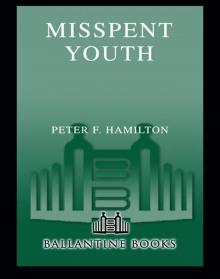 Misspent Youth
Misspent Youth Pandora's Star
Pandora's Star The Evolutionary Void
The Evolutionary Void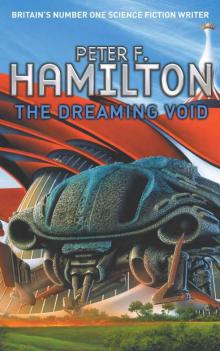 The Dreaming Void
The Dreaming Void Mindstar Rising
Mindstar Rising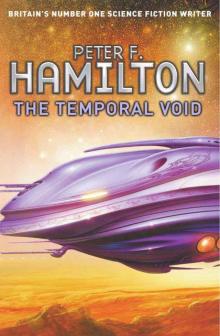 The Temporal Void
The Temporal Void A Quantum Murder
A Quantum Murder The Hunting of the Princes
The Hunting of the Princes Salvation Lost
Salvation Lost The Dreaming
The Dreaming Salvation
Salvation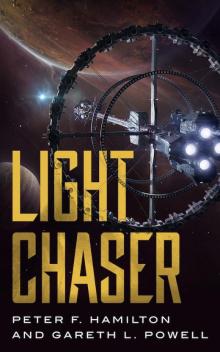 Light Chaser
Light Chaser The Mandel Files, Volume 2: The Nano Flower
The Mandel Files, Volume 2: The Nano Flower![The Saints of Salvation [British Ed.] Read online](http://i1.bookreadfree.com/22/the_saints_of_salvation_british_ed__preview.jpg) The Saints of Salvation [British Ed.]
The Saints of Salvation [British Ed.] Manhattan in Reverse
Manhattan in Reverse The Secret Throne
The Secret Throne A Window Into Time
A Window Into Time A Second Chance at Eden
A Second Chance at Eden The Nano Flower
The Nano Flower The Confederation Handbook
The Confederation Handbook The Naked God
The Naked God The Saints of Salvation
The Saints of Salvation The Void Trilogy 3-Book Bundle
The Void Trilogy 3-Book Bundle The Abyss Beyond Dreams
The Abyss Beyond Dreams A Voyage Through Air
A Voyage Through Air Judas Unchained
Judas Unchained The Commonwealth Saga 2-Book Bundle
The Commonwealth Saga 2-Book Bundle The Naked God - Flight nd-5
The Naked God - Flight nd-5 Night Without Stars (Chronicle of the Fallers Book 2)
Night Without Stars (Chronicle of the Fallers Book 2) Neutronium Alchemist - Conflict nd-4
Neutronium Alchemist - Conflict nd-4 Reality Dysfunction - Expansion nd-2
Reality Dysfunction - Expansion nd-2 Now We Are Ten: Celebrating the First Ten Years of NewCon Press
Now We Are Ten: Celebrating the First Ten Years of NewCon Press Neutronium Alchemist - Consolidation nd-3
Neutronium Alchemist - Consolidation nd-3 If at First . . . (Short Story)
If at First . . . (Short Story) A Second Chance at Eden nd-7
A Second Chance at Eden nd-7 Judas Unchained cs-2
Judas Unchained cs-2 The Mandel Files, Volume 1
The Mandel Files, Volume 1 Reality Dysfunction — Emergence nd-1
Reality Dysfunction — Emergence nd-1 The Temporal Void (ARC)
The Temporal Void (ARC) The Mandel Files
The Mandel Files Fallen Fragon
Fallen Fragon Misspent Youth (commonwealth saga)
Misspent Youth (commonwealth saga) If at First...
If at First... Best of British Science Fiction 2016
Best of British Science Fiction 2016 The Mandel Files, Volume 2
The Mandel Files, Volume 2 The Naked God - Faith nd-6
The Naked God - Faith nd-6 The Night's Dawn Trilogy
The Night's Dawn Trilogy Pandora's Star cs-2
Pandora's Star cs-2 A Window into Time (Novella)
A Window into Time (Novella)